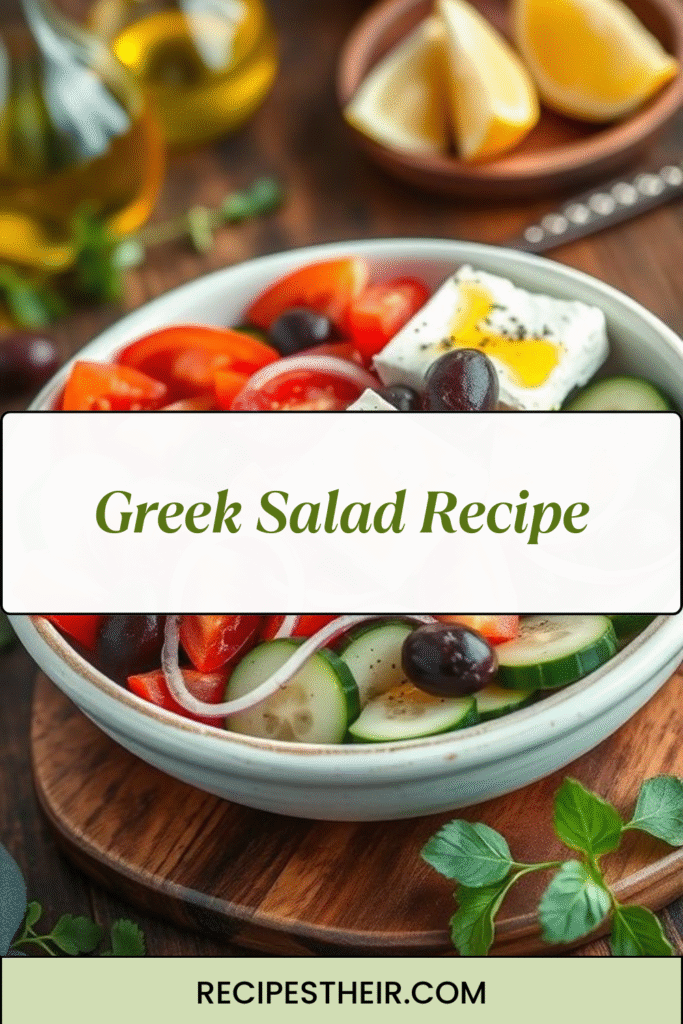When you’re craving something fresh, vibrant, and bursting with Mediterranean flavor, nothing beats a classic Greek salad recipe. Known as Horiatiki in Greece, this iconic dish is a staple of Greek cuisine, made with simple, wholesome ingredients like crisp cucumbers, juicy tomatoes, briny feta cheese, and olives. Whether you serve it as a light lunch, a side dish for grilled meats, or part of a mezze platter, Greek salad is a guaranteed crowd-pleaser.
In this article, we’ll explore everything you need to know about making the perfect Greek salad — from authentic ingredients to step-by-step instructions, serving suggestions, and tips for storing leftovers. By the end, you’ll have your new go-to recipe for a refreshing and healthy dish that’s ready in minutes.

What Makes a Greek Salad Authentic?
A true Greek salad recipe is all about simplicity. Traditional Greek salad does not include lettuce — instead, it focuses on fresh vegetables and bold Mediterranean flavors. The key components are:
- Ripe Tomatoes – The star of the salad. Use firm, sweet, and juicy tomatoes for the best flavor.
- Crisp Cucumbers – Usually peeled and sliced thick for crunch.
- Red Onion – Adds a mild sharpness and beautiful color.
- Kalamata Olives – Briny and rich, they bring that authentic Greek taste.
- Feta Cheese – Traditionally served in a block on top, not crumbled.
- Extra Virgin Olive Oil – A must for flavor and authenticity.
- Dried Oregano – Adds that unmistakable Mediterranean aroma.
Some variations may include green bell peppers or capers, but the beauty of a Greek salad lies in using just a few high-quality ingredients.
Why You’ll Love This Greek Salad Recipe

✔ Quick & Easy – Ready in just 10 minutes.
✔ Healthy & Fresh – Packed with vitamins, minerals, and heart-healthy fats.
✔ Naturally Gluten-Free & Low-Carb – Perfect for most dietary needs.
✔ Versatile – Works as a side dish, main meal, or part of a mezze spread.
✔ Mediterranean Flavor in Every Bite – Tangy, salty, crisp, and refreshing.
Ingredients for the Best Greek Salad
To make this Greek salad recipe, you’ll need:
- 4 medium tomatoes – cut into wedges
- 1 large cucumber – peeled and sliced into half-moons
- 1 small red onion – thinly sliced
- 1 green bell pepper – thinly sliced (optional but traditional)
- 1 cup Kalamata olives – whole or pitted
- 6 oz (170g) block of feta cheese – use the best quality you can find
- ¼ cup extra virgin olive oil
- 1 tbsp red wine vinegar
- 1 tsp dried oregano
- Salt & black pepper – to taste
Step-by-Step Instructions
Follow these simple steps to prepare your authentic Greek salad recipe:
1. Prepare the Vegetables
Wash and pat dry all your vegetables. Cut the tomatoes into wedges, slice the cucumber into half-moons, thinly slice the red onion, and cut the green bell pepper into rings.
2. Assemble the Salad
Place the tomatoes, cucumber, red onion, bell pepper, and olives into a large serving bowl.
3. Make the Dressing
In a small bowl, whisk together the extra virgin olive oil, red wine vinegar, oregano, salt, and pepper.
4. Toss Gently
Pour the dressing over the vegetables and gently toss until everything is well coated.
5. Add the Feta
Place the block of feta cheese on top of the salad. Sprinkle with a little more oregano and drizzle with extra olive oil if desired.
Expert Tips for the Perfect Greek Salad
- Use the Best Olive Oil – Since this recipe is so simple, the flavor of the olive oil really stands out. Choose a high-quality extra virgin variety.
- Keep Feta in a Block – Authentic Greek salad uses a single block of feta placed on top rather than crumbled throughout.
- Serve Immediately – Greek salad tastes best fresh, right after tossing.
- Season at the End – Salt can draw water out of tomatoes, so season just before serving to keep the salad crisp.
Variations of Greek Salad
Although the classic Greek salad recipe is perfect as is, you can customize it to fit your taste:
- Add Lettuce – For a more filling salad, add chopped romaine.
- Include Capers – Adds extra briny flavor.
- Make It a Meal – Top with grilled chicken, shrimp, or chickpeas for extra protein.
- Try Different Cheeses – While feta is traditional, you can experiment with halloumi or goat cheese.
What to Serve with Greek Salad
Greek salad is incredibly versatile. Here are a few pairing ideas:
- Grilled Meats – Lamb chops, chicken souvlaki, or steak.
- Seafood – Grilled fish or shrimp complement the bright flavors.
- Pita Bread & Hummus – Perfect for a Mediterranean mezze platter.
- Rice or Couscous – Turn it into a more substantial meal.
Storing Leftover Greek Salad
Greek salad is best eaten fresh, but if you have leftovers:
- Refrigerate – Store in an airtight container for up to 1 day.
- Keep Feta Separate – If possible, remove the feta block before storing to keep it from becoming soggy.
- Freshen Before Serving – Add a drizzle of olive oil and a pinch of salt before eating leftovers.
Nutritional Benefits
This Greek salad recipe is not just delicious but also highly nutritious:
- Low in Calories – Ideal for a light lunch or dinner side.
- Rich in Antioxidants – Tomatoes, olive oil, and onions provide essential nutrients.
- Heart-Healthy – Olive oil and olives are packed with healthy fats.
- Good Source of Protein – Thanks to the feta cheese.
Final Thoughts
This Greek salad recipe is the perfect combination of crisp, juicy vegetables, creamy feta, and a zesty dressing that ties everything together. Whether you’re planning a summer BBQ, a family dinner, or a quick lunch, this salad is sure to impress.
Give it a try today and bring a taste of the Mediterranean to your table. Once you see how easy and flavorful it is, you’ll find yourself making it again and again.
